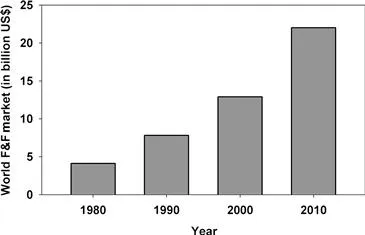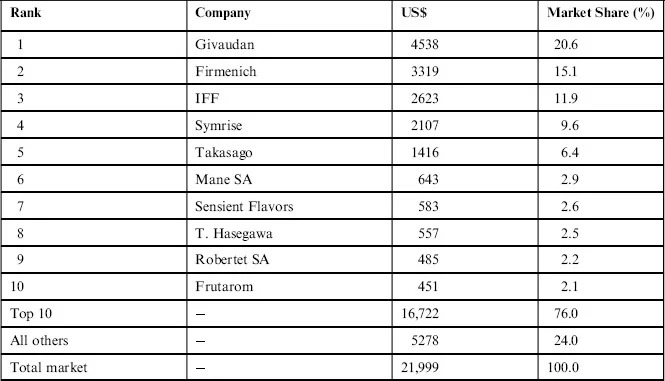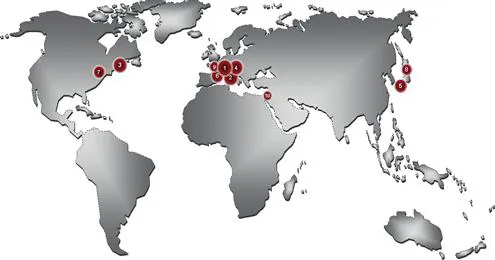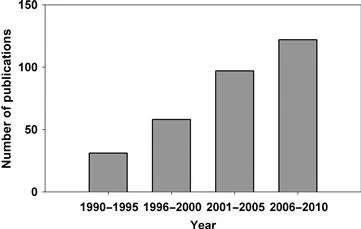
eBook - ePub
Perfume Engineering
Design, Performance and Classification
This is a test
- 170 pages
- English
- ePUB (mobile friendly)
- Available on iOS & Android
eBook - ePub
Perfume Engineering
Design, Performance and Classification
Book details
Book preview
Table of contents
Citations
About This Book
Perfume Engineering is a must-have reference for engineers who design any products that require fragrances, such as perfumes, cosmetics, healthcare and cleaning products.
This book provides the reader with practical guidance on perfume design, performance and classification, from its beginnings as a liquid mixture to the vapour phase, by way of odorant dispersion and olfactory perception. It does this through the application of development and validation models to account for fragrance evaporation, propagation and perception.
Frequently asked questions
At the moment all of our mobile-responsive ePub books are available to download via the app. Most of our PDFs are also available to download and we're working on making the final remaining ones downloadable now. Learn more here.
Both plans give you full access to the library and all of Perlego’s features. The only differences are the price and subscription period: With the annual plan you’ll save around 30% compared to 12 months on the monthly plan.
We are an online textbook subscription service, where you can get access to an entire online library for less than the price of a single book per month. With over 1 million books across 1000+ topics, we’ve got you covered! Learn more here.
Look out for the read-aloud symbol on your next book to see if you can listen to it. The read-aloud tool reads text aloud for you, highlighting the text as it is being read. You can pause it, speed it up and slow it down. Learn more here.
Yes, you can access Perfume Engineering by Miguel A Teixeira,Oscar Rodriguez,Paula Gomes,Vera Mata,Alirio Rodrigues in PDF and/or ePUB format, as well as other popular books in Technology & Engineering & Chemical & Biochemical Engineering. We have over one million books available in our catalogue for you to explore.
Information
Chapter 1
A Product Engineering Approach in the Perfume Industry
1.1 The Flavor and Fragrance Market
1.2 From the Idea to Market: Product Engineering
References
Fragrances are used in a wide variety of daily products like perfumes, cosmetics, toiletries, and household cleaners. The purpose of including fragrances in the formulation of all these different products is to influence consumers, either by enhancing their sensorial properties or simply by signaling the product to be easily recognizable. On their side, consumers are attracted to perfumed products because they are capable of influencing their image, mood, or even their personality. Remarkably, the incorporation of fragrances in products has also the role of improving the evaluations that customers make for the performance of those products: fresh odors are often applied in cleaning products because consumers associate fresh with clean. This bilateral relationship is explained by the power of the sense of olfaction, which surpasses frontiers that other senses cannot reach.
1.1 The Flavor and Fragrance Market
It is no wonder that the business of Flavors and Fragrances (F&F) has become a multibillion dollar market with great economic impact all over the world. Currently, it includes two different fields of operation: (i) the production of raw materials, either extracted from natural sources or synthesized in the laboratory and (ii) the formulation of flavor or fragrances’ blends. Of course, there are many other industries operating in diversified areas of expertise that are also closely related to the F&F business like packaging, marketing, or retail chain companies. In its entirety, the global market of F&F is large and has been continuously growing at good rates over the last decade, featuring an average growth of more than 5% per year. In spite of the economic and financial crisis of 2008, astonishingly the F&F worldwide market has more than doubled in the past 15 years, from US$9.6 billion in 1995 to US$22 billion in 2010 as shown in Fig. 1.1 (Leffingwell and Leffingwell, 2012).

Fig. 1.1 Evolution of the global F&F market in billion US$ for the period 1980–2010. The average annual growth rate exceeds nearly five times the corresponding world population growth, which is estimated at 1.1%. https://www.cia.gov/library/publications/the-world-factbook/geos/xx.html.
Despite the magnitude of this market and the large number of companies operating within its frontiers, the fact is that it is mainly controlled by a restricted group of 10 companies. This is so, because the dynamics of the F&F industry follows the trend of other industries where several mergers, acquisitions or market expansions from the most representative companies (Ziegler, 2007) often occur. The “big fish” companies dominate a total of 76% of the market share, and the top five companies (Givaudan, Firmenich, International Flavors & Fragrances–IFF, Symrise, Takasago) account for more than 60% alone. A summary of such ranking of F&F companies is given in Table 1.1. Consequently, it can be said that this is a closed and strong market that still remains ruled by a small group of companies, although there are hundreds of other small companies operating within it. Perhaps it is one of the reasons behind the secrecy in this industry. To a layman or a regular consumer of perfumes, these companies will be mostly unfamiliar since they do not appear on the shelves of perfume shops or on the packaging of perfumes. And the publicity they receive in the media is rare or even nonexistent. Probably, companies’ names such as Christian Dior, Dolce & Gabbana, Estée Lauder, or Hugo Boss will sound more familiar. However, the fact is that the vast majority of these companies (which work as brand managers) neither do not produce the fragrances themselves nor have perfumers in their staff. In fact, what happens is that when these brand companies spot a gap in their portfolio, then they brief the fragrance houses which will develop the perfume. Thus, companies like Givaudan, Firmenich, or IFF are not only global suppliers of fragrances and flavors (including raw materials and active ingredients for perfumes, cosmetics, and foods) but also manufacturers of perfumes and fragranced products.
Table 1.1
World Market Share for F&F Business per Company in 2010 (Values in Million Dollars)

Another relevant aspect to be highlighted is the comparison between the geographical distribution of main F&F companies, as depicted in Fig. 1.2, with the number of sales. Geographically, the consumption of products containing either flavors or fragrances is asymmetric and in line with the socioeconomic development of countries worldwide. Thus, North America and central Europe are the gross consumers of such products, contributing to more than 50% of the worldwide consumption (Leffingwell and Leffingwell, 2012). They are followed by growing markets like Japan and China, as presented in Fig. 1.3.

Fig. 1.2 Geographical distribution of the top 10 F&F companies in the world in 2009: 1. Givaudan; 2. Firmenich; 3. IFF; 4. Symrise; 5. Takasago; 6. Mane SA; 7. Sensient Flavors; 8. T. Hasegawa; 9. Robertet SA; 10. Frutarom. Adapted with permission from Teixeira (2011). © 2011, M.A. Teixeira.

Fig. 1.3 World consumption of F&F products in 2010. Adapted with permission from Teixeira (2011). © 2011, M.A. Teixeira.
After analyzing the F&F market, it is now time to unravel what is inside F&F companies and what products are derived from them. As in analogy with the market, the core business of the F&F industry can be divided into two main groups: fragrances and flavors. While fragrances are odorous organic chemicals that are used in perfumed products, flavors are intended for the flavoring of foods and beverages. Most of what we perceive from flavors is due to the olfactory perception as well, and so these two fields are closely linked. Hence, their classification depends whether they are mainly perceived by the sense of olfaction or gustation. In simple words, whether they are applied in perfumed or food products, respectively. However, one should not forget that much of what we perceive by our taste is actually influenced by what our nose perceives at the same time. Having said that, sales of fragrances and flavors are nearly equivalent, although flavors have been gaining little ground during the last decade. This increasing need for flavors can be explained by the shift in human lifestyle and philosophy: at the turn of the twenty-first century, the trend in consumers started to be oriented toward healthy, fitness, and diet products (moved by the slogan “you are what you eat”), and thus pushing the industry toward such products. Within the markets for fragrances and flavors, it is possible to have trading of either raw materials (natural, natural–identical, or synthetic) or blends of them. For their part, blends constitute added-value products with more market weight. In the field of flavors, aromas are essentially designed for beverages, bakery, savory, and meat products. In the case of fragrances, the largest application goes to functional perfumes designed for everyday use, which should not to be confused with fine perfumery (luxury products). Examples of such products are soaps, detergents, toiletries, and household cleaners. However, the development of fine fragrances, which are more expensive and have higher added value, is also significant (reaching 21% of the fragrance market).
1.2 From the Idea to Market: Product Engineering
The previous numbers give an idea of the pressure in the F&F industry to produce more and more profitable fragranced products. In fact, as happens in many other businesses, profit is the goal. Thus, if the ideal target would be to create a new and unique piece of art, it is also true that fragrance houses are often asked to develop a fragrance that is appealing to all types of people and will return millions of dollars (Burr, 2008). That explains the importance of product development departments in this industry. Just as an example, and considering the exclusive fine fragrance market for 2009, over 1500 new fine fragrances were released only during that year (compared with less than 50 new ones, 20 years ago). This quest for novel products is a recent trend that has been growing over the last decade to fulfill consumers’ needs and expectations. Currently, it is the market that pulls companies (and their product development teams) to overcome barriers and challenges for the creation of new products. This issue has been explored in a multitude of companies for many years, following a more or less empirical methodology. Nowadays, it is a subject of its own: what is now called Product Engineering, product development, or product design (Charpentier, 1997; Ulrich and Eppinger, 2000; Cussler and Moggridge, 2001; Mata et al., 2004; Wei, 2007; Wesselingh et al., 2007; Cussler et al., 2010). Within the chemical business it is called chemical product design. Books addressing this topic started to show up in the beginning of the 1990s but until now they are less than a couple dozens. The most successful so far is probably that of Karl T. Ulrich and Steven D. Eppinger which is already at its fifth edition (Ulrich and Eppinger, 2011). In terms of scientific papers, the numbers are larger, following a similar trend: started with few in the beginning of the 1990s, but since then they have been increasing as shown in Fig. 1.4. Probably, it is more relevant to the fact that product design and development has become a discipline of many curricula of university courses. As stated in the 1990s by J. A. Wesselingh, S. Kiil, and M. E. Vigild, who wrote a book and give lectures on this topic: large changes were coming in the chemical industry, and that they should be looking at higher-value (structured) products.

Fig. 1.4 Track record of scientific papers with “Product Engineering” appearing in topics published in international journals from 1990 to 2010. Scopus, “Product Engineering” in title, abstract, and key words, Date of consultation February, 2012.
We consider that Product Engineering can be seen as a stepwise methodology: it starts with the identification of market needs, then their translation into product specifications (physicochemical properties that can be measured) which will help generating ideas and, finally, ends up with the selection of the best ones for the manufacture of the product. Throughout all this process, it must encompass other relevant topics like economic evaluations, risk assessment, project management, and sustainability. At a glance, it defines the “how,” “when,” and “where” a new product should be developed and launched into a market. This perspective is shared by several authors in the literature as well. Cussler and Moggridge (2001) consider that Product Engineering emphasizes decisions made before those of chemical process design, a more familiar topic for chemical engineers. Moreover, according to Ulrich and Eppinger (2011), Product development is the set of activities beginning with the perception of the market opportunity and ending in the production, sale, and delivery of a product. In our opinion, the picture of Product Engineering (or product design and development) drawn by the different authors looks very similar because they share the same fundamentals. Of course, small differences arise as different authors give emphasis to different aspects of the development process. But the industry itself is not away from these approaches: a similar stepwise framework, widely used, is the Stage-Gate™ Product Development Process (SGPDP). It is based on what the industry project teams do better and applies those product design strategies based on decision analysis to the development of novel products (Cooper, 2001; Seider et al., 2010). Having said that, should we be able to apply the fundamentals of Product Engineering to the F&F business? F&F companies are no exception on...
Table of contents
- Cover image
- Title page
- Table of Contents
- Copyright
- Preface
- Chapter 1. A Product Engineering Approach in the Perfume Industry
- Chapter 2. Design of Perfumes
- Chapter 3. Performance of Perfumes
- Chapter 4. Classification of Perfumes–Perfumery Radar
- Chapter 5. Looking Ahead